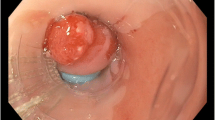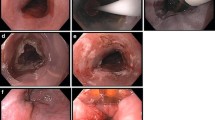Abstract
Barrett’s oesophagus is the only know pre-cursor to oesophageal adenocarcinoma. The incidence of OAC is growing rapidly in the western world with a poor prognosis for most with a 5-year survival of only 15 %. The approach to treating patients with neoplasia arising within BE has dramatically changed in the past 5 years. Resection of visible lesions with endoscopic mucosal resection followed by field ablation with radio-frequency ablation is now the accepted standard of care in these patients worldwide. This combined approach has shown high rates of disease reversal in several high quality clinical trials but also large volume registry studies. As well as being a minimally invasive and oesophageal sparing interventions compared to surgery with oesophagectomy, endoscopic therapy has proved to be safe and emerging long-term data show sustained benefit in the majority of patients and low rates of cancer progression. However, in a sub-group of patients, recurrences have been reported after successful endoscopic therapy making it mandatory to follow these patients post therapy. Improvements in endoscopic imaging continue to aid early diagnosis, and in turn, this will allow clinicians the ability to offer patient’s treatment at an early stage.
Similar content being viewed by others
References
Papers of particular interest, published recently, have been highlighted as: • Of importance •• Of major importance
Bhat S, Coleman HG, Yousef F, et al. Risk of malignant progression in Barrett's esophagus patients: results from a large population-based study. J Natl Cancer Inst. 2011;103(13):1049–57.
Hvid-Jensen F, Pedersen L, Drewes AM, et al. Incidence of adenocarcinoma among patients with Barrett's esophagus. N Engl J Med. 2011;365(15):1375–83.
Ronkainen J, Aro P, Storskrubb T, et al. Prevalence of Barrett's esophagus in the general population: an endoscopic study. Gastroenterology. 2005;129(6):1825–31.
Buttar NS, Wang KK, Sebo TJ, et al. Extent of high-grade dysplasia in Barrett's esophagus correlates with risk of adenocarcinoma. Gastroenterology. 2001;120(7):1630–9.
Fitzgerald RC, di Pietro M, Ragunath K, et al. British Society of Gastroenterology guidelines on the diagnosis and management of Barrett's oesophagus. Gut. 2014;63(1):7–42. These two national guidelines from the USA and UK provide up to date position statements on the diagnosis and management of Barrett's oesophagus.
Spechler SJ, Sharma P, Souza RF, et al. American Gastroenterological Association medical position statement on the management of Barrett's esophagus. Gastroenterology. 2011;140(3):1084–91. These two national guidelines from the USA and UK provide up to date position statements on the diagnosis and management of Barrett's oesophagus.
Dunkin B, Martinez J, Bejarano P, et al. Thin-layer ablation of human esophageal epithelium using a bipolar radiofrequency balloon device. Surgical Endoscopy. 2006;20(1):125–30.
Shaheen NJ, Sharma P, Overholt BF, et al. Radiofrequency ablation in Barrett's esophagus with dysplasia. N Engl J Med. 2009;360(22):2277–88. First ever Randomised control study of RFA in Barrett's oeosphagus – a landmark study that set the scene for further studies.
Bulsiewicz WJ, Kim HP, Dellon ES, et al. Safety and efficacy of endoscopic mucosal therapy with radiofrequency ablation for patients with neoplastic Barrett's esophagus. Clin Gastroenterol Hepatol. 2013;11(6):636–42. Large volume studies from USA and Europe reinforcing the findings of AIM dysplasia.
Phoa KN, Pouw RE, van Vilsteren FG, et al. Remission of Barrett's esophagus with early neoplasia 5 years after radiofrequency ablation with endoscopic resection: a Netherlands cohort study. Gastroenterology. 2013;145(1):96–104. Large volume studies from USA and Europe reinforcing the findings of AIM dysplasia.
Haidry RJ, Dunn JM, Butt MA, et al. Radiofrequency ablation and endoscopic mucosal resection for dysplastic Barrett's esophagus and early esophageal adenocarcinoma: outcomes of the UK National Halo RFA Registry. Gastroenterology. 2013;145(1):87–95. Collectively these three studies show large volume data from The USA, Europe and UK on sustained durability of RFA in patients with Barrett's neoplasia.
Orman ES, Li N, Shaheen NJ. Efficacy and durability of radiofrequency ablation for Barrett's esophagus: systematic review and meta-analysis. Clin Gastroenterol Hepatol. 2013;11(10):1245–55. Collectively these three studies show large volume data from The USA, Europe and UK on sustained durability of RFA in patients with Barrett's neoplasia.
Shaheen NJ, Overholt BF, Sampliner RE, et al. Durability of radiofrequency ablation in Barrett's esophagus with dysplasia. Gastroenterology. 2011;141(2):460–8. Collectively these three studies show large volume data from The USA, Europe and UK on sustained durability of RFA in patients with Barrett's neoplasia.
Orman ES, Kim HP, Bulsiewicz WJ, et al. Intestinal metaplasia recurs infrequently in patients successfully treated for Barrett's esophagus with radiofrequency ablation. Am J Gastroenterol. 2013;108(2):187–95.
Gupta M, Iyer PG, Lutzke L, et al. Recurrence of esophageal intestinal metaplasia after endoscopic mucosal resection and radiofrequency ablation of Barrett's esophagus: results from a US Multicenter Consortium. Gastroenterology. 2013;145(1):79–86.
Shaheen NJ, Kim HP, Bulsiewicz WJ, et al. Prior fundoplication does not improve safety or efficacy outcomes of radiofrequency ablation: results from the U.S. RFA Registry. J Gastrointest Surg. 2013;17(1):21–8.
van Vilsteren FG, Alvarez HL, Pouw RE, et al. Predictive factors for initial treatment response after circumferential radiofrequency ablation for Barrett's esophagus with early neoplasia: a prospective multicenter study. Endoscopy. 2013;45(7):516–25. Novel study demonstrating that successful RFA is dependent on several key pre-treatment parameters.
Phoa KN, van Vilsteren FG, Weusten BL, et al. Radiofrequency ablation vs endoscopic surveillance for patients with Barrett esophagus and low-grade dysplasia: a randomized clinical trial. JAMA. 2014;311(12):1209–17. First Randomises study to explore the role of RFA in patients with low grade dysplasia in Barrett's oesophagus – a key study.
Curvers WL, Ten Kate FJ, Krishnadath KK, et al. Low-grade dysplasia in Barrett's esophagus: overdiagnosed and underestimated. Am J Gastroenterol. 2010;105(7):1523–30.
Srivastava A, Hornick JL, Li X, et al. Extent of low-grade dysplasia is a risk factor for the development of esophageal adenocarcinoma in Barrett's esophagus. Am J Gastroenterol. 2007;102(3):483–93.
Hur C, Choi SE, Rubenstein JH, et al. The cost effectiveness of radiofrequency ablation for Barrett's esophagus. Gastroenterology. 2012;143(3):567–75.
Compliance with Ethics Guidelines
Conflict of Interest
Prateek Sharma declares grants to University of Kansas School of Medicine and the VA Medical Center, from Effexus, NinePoint, Olympus Inc., and CDx Diagnostics. Dr. Haidry declares a consultancy fee paid to University College Hospital NHS foundation Trust from Covidien in the form of an educational grant to host training seminars on RFA to train endoscopists and Pentax Medical Europe. Laurence Lovat declares travel expenses/accommodations from Covidien, Inc. for attending RFA Academia meetings in Europe. Laurence Lovat has also received unrestricted educational grants to help develop the UK RFA Registry. No access to data or manuscripts has been requested or provided.
Human and Animal Rights and Informed Consent
This article does not contain any studies with human or animal subjects performed by any of the authors.
Author information
Authors and Affiliations
Corresponding author
Additional information
This article is part of the Topical Collection on GI Oncology
Rights and permissions
About this article
Cite this article
Haidry, R., Lovat, L. & Sharma, P. Radiofrequency Ablation for Barrett’s Dysplasia: Past, Present and the Future?. Curr Gastroenterol Rep 17, 13 (2015). https://doi.org/10.1007/s11894-015-0433-5
Published:
DOI: https://doi.org/10.1007/s11894-015-0433-5




